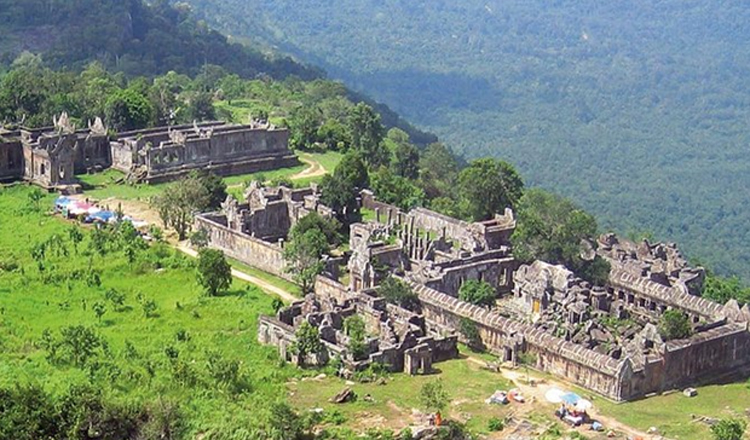Preah Vihear Temple, Cambodia
🏰 Preah Vihear Temple: A Majestic Khmer Masterpiece
Preah Vihear Temple is perched high atop the Dineh Mountain in northern Cambodia, offering breathtaking views of the surrounding plains and a fascinating glimpse into the grandeur of ancient Khmer architecture. With its historical significance, architectural beauty, and dramatic setting, Preah Vihear is a must-visit destination for history and culture lovers.
🏯 Temple Overview
Preah Vihear is a Hindu temple dedicated to Shiva and was built between the 9th and 12th centuries. The temple is unique due to its layout, which follows the natural contours of the mountain, creating a dramatic series of terraces, stairways, and pavilions. The temple complex is a stunning example of Khmer architecture at its peak.
📜 Historical Significance
Preah Vihear’s location on a mountain, combined with its unique construction, makes it a symbolic and spiritual place. The temple was used for centuries by Hindu worshippers, and later by Buddhists, as the area became a significant religious and cultural site.
-
UNESCO World Heritage Site: Preah Vihear was declared a UNESCO World Heritage Site in 2008 due to its cultural and historical value.
-
Cambodian vs. Thai Ownership Dispute: The temple has been at the center of a long-standing territorial dispute between Cambodia and Thailand, though it is officially under Cambodia’s jurisdiction today.
🏞️ Top Attractions at Preah Vihear
🛕 The Temple Complex
-
The temple is divided into five levels, with each one containing unique architectural elements such as sandstone steps, intricate carvings, and stone pavilions.
-
The central sanctuary at the summit of the mountain is a stunning sight, often wrapped in mist.
📸 Panoramic Views
From the temple, you can witness sweeping views of Thailand’s Isan region and Cambodia’s northern plains. The setting is especially dramatic at sunrise and sunset.
🌿 The Staircase Approach
To reach the temple, you ascend a long, steep staircase that is flanked by ancient stone balustrades, making the climb feel both sacred and awe-inspiring.
🏞️ The Surrounding Natural Beauty
The mountain and surrounding area offer pristine forest and a peaceful atmosphere, ideal for nature lovers and those wanting to escape the hustle and bustle.
🛕 What to See in the Temple Complex
-
The Sanctuary: The main shrine at the temple, once dedicated to the Hindu god Shiva.
-
The Hall of Mirrors: An impressive structure that offers a reflective, spiritual quality.
-
Galleries and Carvings: Intricate carvings depicting scenes of Hindu mythology, especially around the central sanctuary and surrounding walls.
🚗 How to Get There
-
By Car: Preah Vihear Temple is located about 240 km north of Siem Reap and approximately 120 km from Phnom Penh. The most common way to get there is by car or private transport.
-
By Motorcycle: For the adventurous traveler, a motorcycle is also an option, though the terrain can be quite challenging.
-
Guided Tours: It’s advisable to take a local guide for the most informative experience, especially due to the temple’s rich history and the language barrier.
🛏️ Nearby Accommodations
-
Preah Vihear Boutique Hotel (10 km from the temple) – A simple but comfortable place to stay near the temple.
-
Vattanac Resort (15 km away) – A resort offering modern amenities with beautiful mountain views.
-
Guesthouses: There are a number of affordable guesthouses in Sangkum Thmei for budget travelers.
🌞 Best Time to Visit Preah Vihear
-
November to March: Dry season with cooler temperatures, making it the best time for hiking and temple exploration.
-
April to June: Hot but less crowded, ideal for those seeking solitude.
-
Avoid the rainy season (July to October) due to potential flooding and difficult access.
💡 Travel Tips
-
🌄 Get There Early: Preah Vihear can get crowded later in the day, especially with tour groups. Arrive early to experience the temple in peace.
-
👗 Dress Modestly: As a religious site, it’s important to dress respectfully by covering shoulders and knees.
-
🥾 Wear Comfortable Shoes: The climb to the top is steep and rocky, so wear sturdy footwear.
-
💧 Bring Water: The temple is at high altitude, so it can get hot and dry; stay hydrated while you explore.
🌟 Why Visit Preah Vihear Temple?
Preah Vihear is perfect for travelers interested in history, architecture, and stunning views. Its high elevation, dramatic scenery, and tranquil setting make it one of the most atmospheric temple complexes in Cambodia, providing a more serene experience compared to the busier Angkor Wat.


